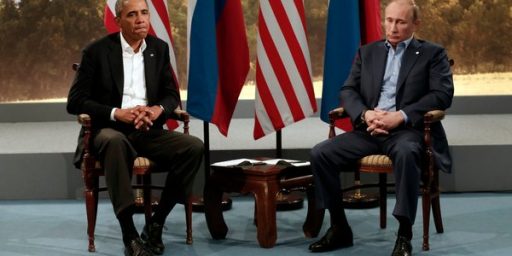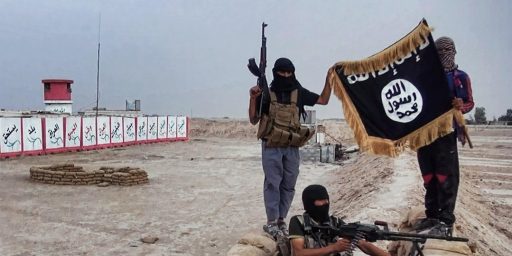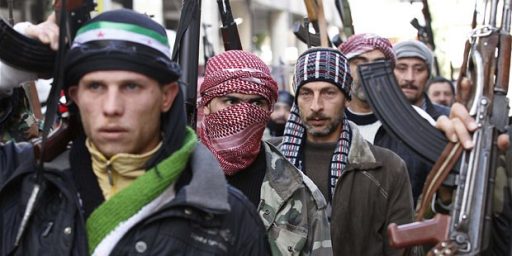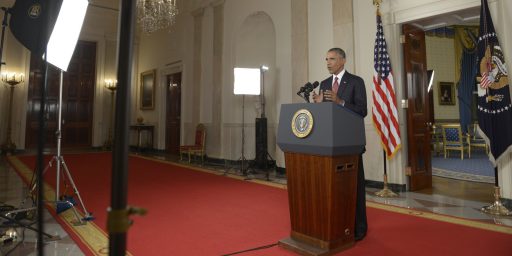ISIS Wasn’t The Only Target We Hit In Syria Last Night
ISIS wasn’t the only target of America’s air strikes in Syria last night, we also hit targets associated with an al Qaeda linked group that heretofore had not received much attention in the media:
U.S. military forces attacked more than just the Islamic State in Syria on Monday night. President Obama confirmed in his brief remarks on Tuesday morning that he ordered airstrikes against a group of “seasoned al-Qaeda operatives” in Syria who have become known as the Khorasan Group.
In a statement describing the air assault, U.S. Central Command said the action was taken “to disrupt…”imminent attack plotting against the United States and Western interests.”
Separately, the United States has also taken action to disrupt the imminent attack plotting against the United States and Western interests conducted by a network of seasoned al-Qa’ida veterans – sometimes referred to as the Khorasan Group – who have established a safe haven in Syria to develop external attacks, construct and test improvised explosive devices and recruit Westerners to conduct operations. These strikes were undertaken only by U.S. assets.”
The military carried out eight strikes against the Khorasan Group west of Aleppo, compared to 14 that were launched against ISIS targets on the first day of the Syria campaign.Obama said the airstrikes made clear that “we will not tolerate safe havens for terrorists who threaten our people.”
That officials used the word “imminent” to describe the threat posed by the Khorasan Group is significant, because it suggests those terrorists are actually more of a danger to the U.S. homeland than ISIS. Obama and senior Cabinet members have said they have no indication that ISIS is intent on or capable of carrying out a terrorist attack inside the United States, although they have warned about foreign ISIS fighters carrying U.S. passports who could return.
Rosie Gray explains how this Khorsan Group seemingly came out of nowhere:
WASHINGTON — An Al-Qaeda-connected group that the Obama administration has targeted with airstrikes alongside ISIS was almost totally unknown to the American public until the U.S. started bombing them, though sources say the group has been known to the administration and to Congress for some time.
The U.S. claims that Khorasan, an Al-Qaeda-linked terrorist group said to be led by an operative named Muhsin al-Fadhli, was a direct threat to the U.S homeland. Little is known about al-Fadhli, though the Department of State says he was based in Iran. But hardly any public information was available about the group before this week and some are suggesting the Khorasan group is simply a renaming of already-known Al-Qaeda operatives in Syria.
That started to change in the last week, as stories about Khorasan began appearingin the media. U.S. officials have described the group as being part of Jabhat al-Nusra, an Al-Qaeda affiliate in Syria fighting both Syrian President Bashar al-Assad’s forces as well as ISIS.
(…)
An Amnesty International report on drones in Pakistan from October 2013 refers to an “al-Qa’ida-linked outfit” called Mujahideen Khorasan, but is unclear if it’s the same Khorasan. A source that was briefed on Khorasan in June said that the counterterrorism community believes that between 10 and 20 top Al Qaeda people had gone to Syria from Waziristan “to link up in Syria and establish a new AQ affiliate in Syria that would be focused on training and deploying against the West.”
“The group has been referred to elliptically in open-source reporting for several months now,” said Daveed Gartenstein-Ross, a counter-terrorism analyst at the Foundation for Defense of Democracies. Gartenstein-Ross said that the composition and size of the group is still unclear, though: “At the very least, number one, it’s embedded with Jabhat al-Nusra but it’s a separate organization from Nusra.” The name, he said, “has particular eschatological meanings related to jihadist views of the end times.”
Gartenstein-Ross said there could be more information coming out about other aspects of Khorasan: “It’s possible that information that’s coming out about the Khorasan shura [or council of leaders] is about its operational wing rather than information abut the entirety of the group. It certainly seems it’s more than just an external operations capability.”
The group, he said, appears to be connected to Ibrahim al-Asiri, the bomb maker for Al-Qaeda in the Arabian Peninsula who was connected to the underwear bomber.
Both Gartenstein-Ross and Mustafa Alani, Senior Advisor and Program Director in Security and Terrorism Studies at the Gulf Research Center, were skeptical of Al-Fadhli’s reported role. “I’m not sure the information is accurate,” Alani said. “Muhsih Al Fadlhi is not the quality of the leader you’d see. He’s not a commander, not a field commander. He’s more a preacher then a commander.”
Aaron Zelin, an expert on extremist groups at the Washington Institute, said there was “no difference” between Khorasan and Jabhat al-Nusra.
“They are AQ members dispatched by Zawahiri that were based in AfPak or Iran to Syria to build up JN’s external operations capabilities since there’s more operational space and closer to the West,” Zelin said. He said there were reports about Khorasan going back “at least 6-18 months.”
From this description, then, it looks as though Khorsan is really just an offshoot of AQAP rather than an independent group on its own. Whatever the case may be, it is at least somewhat interesting that the Administration chose to strike this group at the same time that it was engaging in the far more controversial strikes against ISIS.






FYI: Chris Dickey is reporting that the air forces of Saudi Arabia, Jordan, Bahrain, and the UAE also took part in the raids:
http://www.thedailybeast.com/articles/2014/09/23/arab-kings-vs-isis-barbarians.html
more jv teams on the cusp?